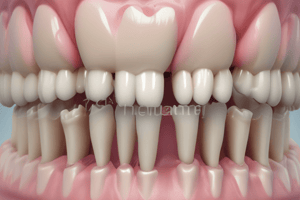Podcast
Questions and Answers
Explain the increased risk of dental implant failure in smokers compared to nonsmokers.
Explain the increased risk of dental implant failure in smokers compared to nonsmokers.
Smokers have double the risk of dental implant failure compared to nonsmokers, and they also have higher rates of peri-implantitis due to the effects of smoking on oral health and healing processes.
What considerations should clinicians communicate to current smokers regarding implant therapy?
What considerations should clinicians communicate to current smokers regarding implant therapy?
Clinicians must communicate the increased risk of implant failure to current smokers, despite smoking not being an absolute contraindication for implant therapy.
Why is a thorough periodontal examination crucial before implant therapy?
Why is a thorough periodontal examination crucial before implant therapy?
Thorough periodontal examination before implant therapy is crucial for assessing periodontal disease status, oral hygiene, and mucogingival parameters, which can impact the success of implant therapy.
What factors put patients at higher risk for implant failure?
What factors put patients at higher risk for implant failure?
What issues are associated with lack of keratinized mucosa around implants?
What issues are associated with lack of keratinized mucosa around implants?
Why is adequate bone volume necessary for standard implant placement?
Why is adequate bone volume necessary for standard implant placement?
What should be included in site-specific examination for implant placement?
What should be included in site-specific examination for implant placement?
What are the guidelines for safe implant placement?
What are the guidelines for safe implant placement?
What elements should be considered in esthetic analysis of an implant patient?
What elements should be considered in esthetic analysis of an implant patient?
Why should implant sites in close proximity to anatomical structures be carefully evaluated?
Why should implant sites in close proximity to anatomical structures be carefully evaluated?
Why is careful evaluation of the location of the inferior alveolar canal crucial?
Why is careful evaluation of the location of the inferior alveolar canal crucial?
What adjunctive diagnostic assessments aid in diagnosis and treatment planning for implant therapy?
What adjunctive diagnostic assessments aid in diagnosis and treatment planning for implant therapy?
What are some systemic factors that influence the success rate of dental implants?
What are some systemic factors that influence the success rate of dental implants?
What is the associated risk of implant failure for smoking and radiotherapy?
What is the associated risk of implant failure for smoking and radiotherapy?
Is poor glycemic control an absolute contraindication for implant therapy in patients with diabetes?
Is poor glycemic control an absolute contraindication for implant therapy in patients with diabetes?
What are some other medical conditions that may modify the treatment plan for dental implants?
What are some other medical conditions that may modify the treatment plan for dental implants?
In what cases is getting clearance from the patient’s physician required for dental implants?
In what cases is getting clearance from the patient’s physician required for dental implants?
Why is a thorough systemic evaluation important prior to planning for dental implants?
Why is a thorough systemic evaluation important prior to planning for dental implants?
How does smoking affect the periodontium?
How does smoking affect the periodontium?
Flashcards are hidden until you start studying
Study Notes
Dental Implant Therapy Considerations
- Smokers have double the risk of dental implant failure compared to nonsmokers, and they also have higher rates of peri-implantitis.
- Clinicians must communicate the increased risk of implant failure to current smokers, despite smoking not being an absolute contraindication for implant therapy.
- Thorough periodontal examination before implant therapy is crucial for assessing periodontal disease status, oral hygiene, and mucogingival parameters.
- Patients with a history of periodontitis, poor oral hygiene, or certain mucogingival conditions are at higher risk for implant failure.
- Lack of keratinized mucosa around implants is associated with plaque buildup, inflammation, and mucosal recession.
- Adequate bone volume both buccopalatally/-lingually and apico-coronally is necessary for standard implant placement.
- Site-specific examination, including bone height and width evaluation, should be performed using digital palpation and imaging techniques.
- Guidelines for safe implant placement include specific mesiodistal space, bone thickness, distance from adjacent teeth, and space between adjacent implants.
- Esthetic analysis of an implant patient should consider various elements including smile line, gingival phenotype, tooth size and space distribution, and occlusal assessment.
- Implant sites in close proximity to anatomical structures such as maxillary sinuses, nasal cavities, and the nasopalatine canal should be carefully evaluated.
- Careful evaluation of the buccolingual and apico-coronal location of the inferior alveolar canal in the mandible is crucial, typically achieved through CBCT.
- Adjunctive diagnostic assessments such as imaging, diagnostic wax-up, and clinical photographs aid in diagnosis and treatment planning.
Studying That Suits You
Use AI to generate personalized quizzes and flashcards to suit your learning preferences.





